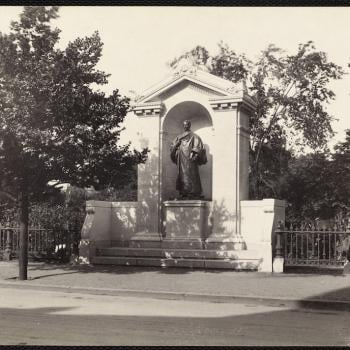 Eleanore Elizabeth Gordon was born on this day in 1852, in Hamilton, Illinois.
Eleanore Elizabeth Gordon was born on this day in 1852, in Hamilton, Illinois.
Eleanore was a remarkable individual, a nineteenth century Unitarian minister and leader of the Iowa Sisterhood.
Unitarian Universalist minister and scholar Carol Hepokoski wrote a succinct summary of the Iowa Sisterhood.
The leading force within the Iowa Sisterhood was Mary Augusta Safford. She organized seven societies throughout her ministry, and she encouraged other women into the missionary ministry. She began her organizing with a Unitarian church in Hamilton, Ill. in 1878. She moved on to Humboldt, Iowa, in 1880. From 1885 to 1899, she was based in Sioux City, where, assisted by her friend the Reverend Eleanor Gordon, she helped form an active and vigorous congregation. Safford moved next to Des Moines, where she served from 1899 to 1910, revitalizing the church building and congregation. In addition to her parish work, she held leadership positions in regional and national Unitarian associations. She served as chaplain in the Iowa state legislature. She also was president of the Iowa Suffrage Association and lectured widely on women’s rights, philosophy, and poetry. She understood her role as missionary minister, strengthening struggling societies and creating new ones.
Eleanor Gordon followed her life-long friend Mary Safford into the Unitarian ministry. After assisting Safford in Sioux City from 1889–1896, she moved on to serve parishes in Iowa City (1896–90), Burlington (1900–02), Fargo, N. D. (1902–04), and Des Moines (1904–06). Safford and Gordon published the missionary magazine Old and New for many years through the Iowa Unitarian Association. They retired together to Orlando, Florida, where they (as a matter of course) organized a Unitarian society in 1912.
Another very active member of the Iowa Sisterhood was Eliza Tupper Wilkes. She founded eight societies, primarily in South Dakota and Minnesota, served as director of the Iowa Unitarian Conference, and secretary of the Post Office Missions of St. Paul, Minnesota. Like her other “Iowa Sisters,” she recommended and trained women to the missionary ministry.
Other women ministers who are considered to be part of the Iowa Sisterhood are: Martha Chapman Aitken, Mary Leggett Cooke, Caroline Bartlett Crane, Mary Graves, Marie Jenney Howe, Ida Hultin, Marion Murdoch, Anna Jane Norris, and Helen Grace Putnam. They organized and served parishes in Nebraska, Kansas, Colorado, the Dakotas, Minnesota, Wisconsin, Illinois, and Ohio in addition to Iowa. Some of these women served in co-ministries with husbands or female friends. Many were active in the women’s suffrage movement. Several were involved in leadership positions within regional denominational associations. Many endured great hardships and low salaries as missionary ministers on the Western frontier. Collectively, they helped extended liberal religion into the Prairie states.
Raised in a family with New Hampshire Unitarian roots, early on Eleanore rebelled against the theological and social constraints of Christian orthodoxy and the rules for women’s place within normative culture. Through a voracious appetite for literature she found her vistas begin to open. With the limited financial support her family could provide Eleanore attended the University of Iowa for a single year before embarking upon her first career as a teacher and principal.
Her closest friend from childhood was Mary Augusta Safford. From early on Mary determined to enter the Unitarian ministry. The two organized an independent Unitarian congregation in Hamilton, which attracted the attention of Jenkin Lloyd Jones, secretary of the Western Unitarian Conference, and a leading figure in the radical wing of Unitarianism. He was able to offer Mary the pulpit at Humbolt Iowa. Eleanore accompanied Mary, taking a job as a principal. There Eleanore began preaching from time to time. When Mary took her next pulpit in Sioux City, Eleanore came as her assistant.
Following a year of theological study at Cornell, the Sioux City congregation Eleanore was ordained. She served the Conference, as pastor of congregations in Iowa, North Dakota and Florida. During this time she remained an intimate friend with Mary and at one church they served as co-ministers.
In our time considering Mary & Eleanore’s relationship is perhaps inescapable. They certainly became life-companions and supporters of each other throughout their lives and retired together to Florida. Other details are lost to the mists of history. Following Mary’s death Eleanore returned to Iowa, where she died in 1942.
She lived through an exciting period, the first in American Unitarian history where women took significant leadership roles. There would be an ebb in this tide, before its true flood at the end of the twentieth century, but she showed the intelligence, grit, and skill that would be demonstrated by a succession of women stepping into their rightful place in the pulpits and among the leadership of a society that would become unalterably transformed by their presence.
We owe a lot to Eleanore and to Mary and to all that glorious band.
May they long be remembered and their lives and ministry celebrated…












